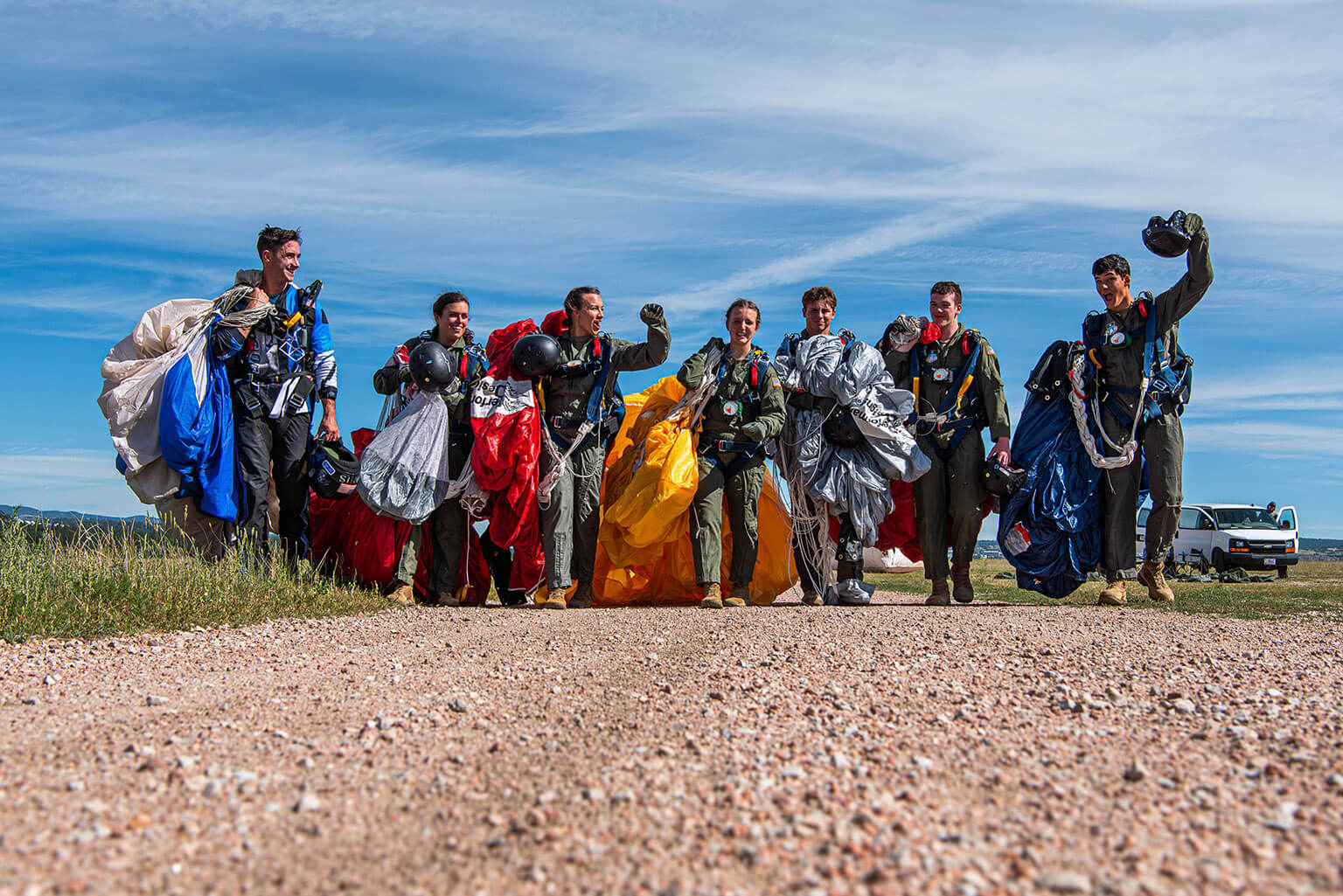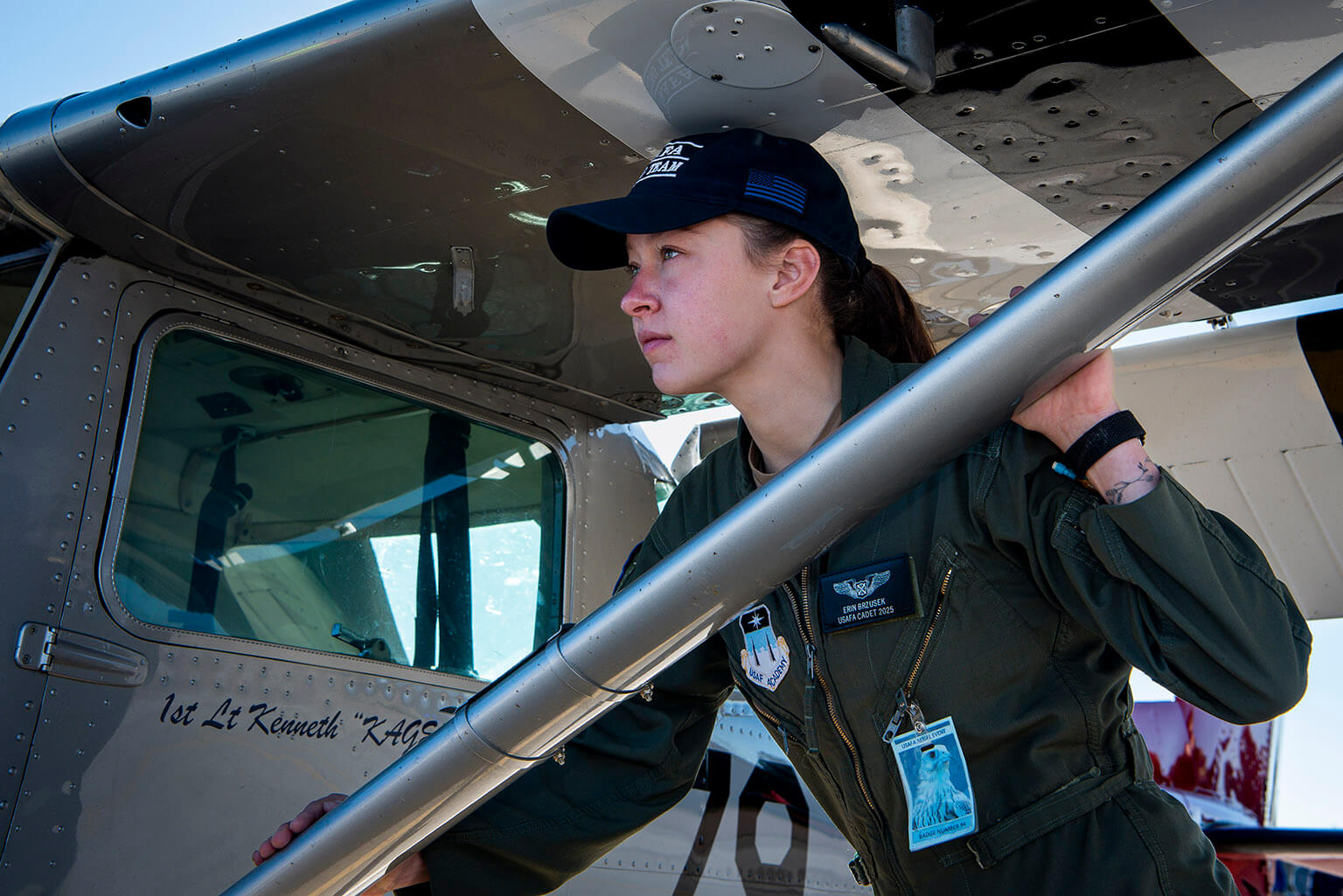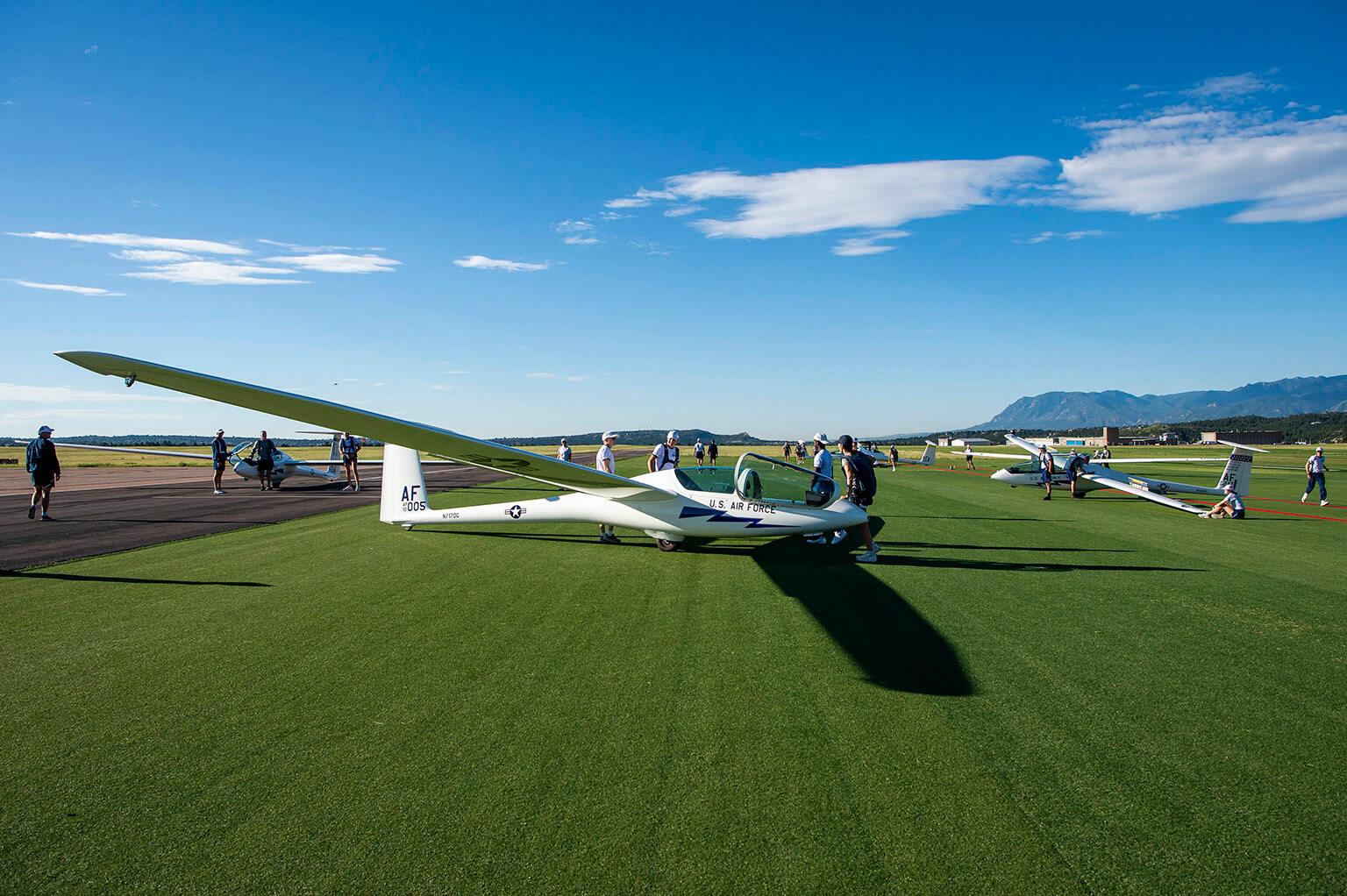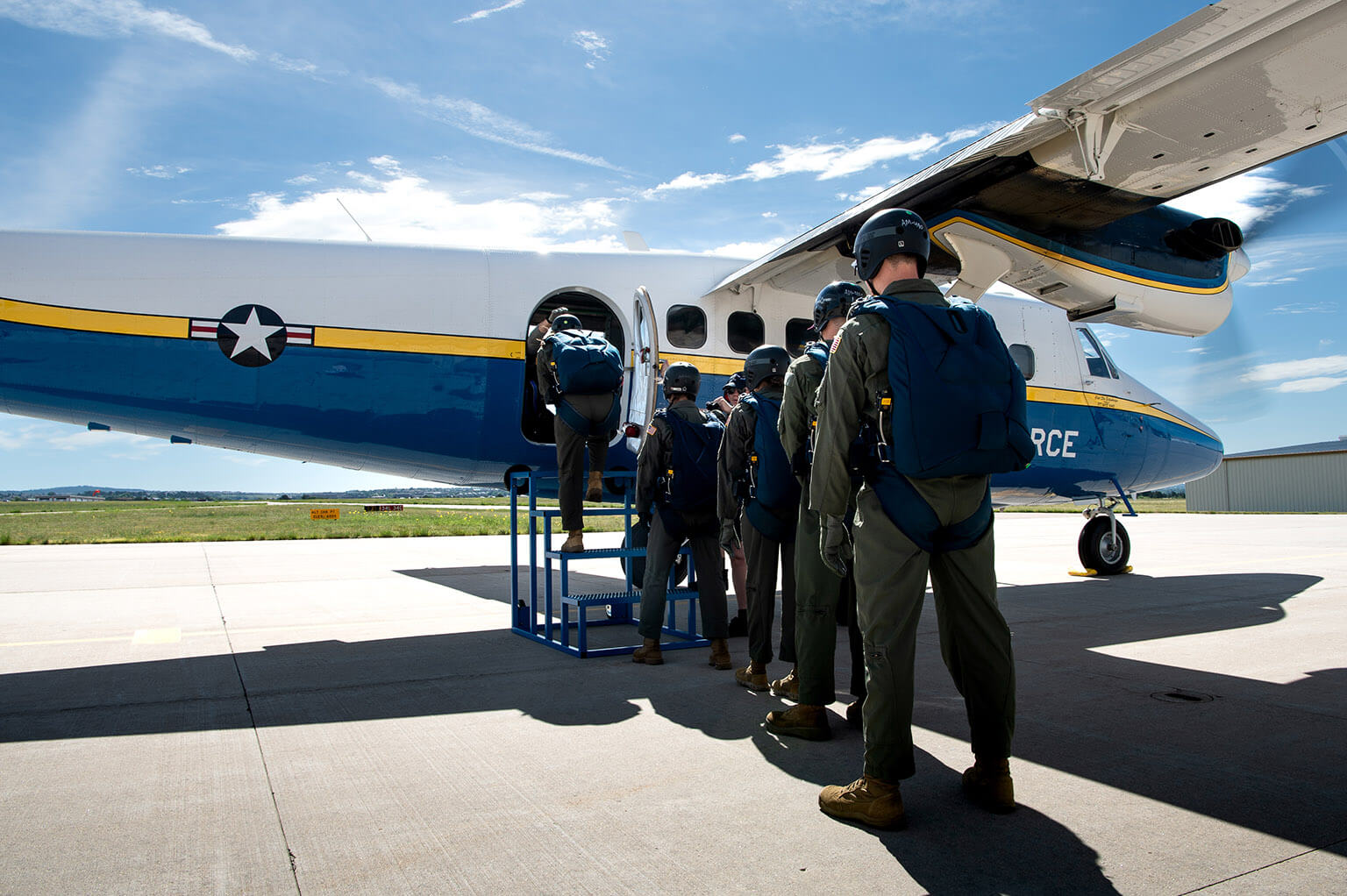Airmanship programs turn cadets into aviators
 Cadets return from an Aug. 15, 2023, jump from a UV-18B Twin Otter in the U.S. Air Force Academy parachuting program. Parachuting is one of the Academy’s four Airmanship Programs. (U.S. Air Force photo by Trevor Cokley)
Cadets return from an Aug. 15, 2023, jump from a UV-18B Twin Otter in the U.S. Air Force Academy parachuting program. Parachuting is one of the Academy’s four Airmanship Programs. (U.S. Air Force photo by Trevor Cokley)
By Randy Roughton
U.S. Air Force Academy Strategic Communications
U.S. AIR FORCE ACADEMY, Colo.- U.S. Air Force Academy Airmanship programs introduce cadets to flying fundamentals and potential careers as Air Force aviators.
The Airmanship Experience Model
Cadets develop airmanship through the Academy’s Airmanship Experience Model, said Lt. Col. Daniel Bellissimo, chief of current operations.
The model includes powered and unpowered flight concepts, navigation instruction, and their real-life application. The virtual-reality flight simulator courses teach introductory flying fundamentals. They also teach rated career field education to ensure cadets are interested in rated careers and eligible. Unpowered flight is a live-flight program that allows cadets to pilot a glider, perform aerobatics and solo-fly the aircraft. Parachuting enables cadets to train for and accomplish free-fall parachuting. In powered flight, cadets learn and employ the basic flying fundamentals of takeoff, landing and visual flight rules in the T-53 Kadet II with the possibility of solo flight.
Developing air-mindedness
Airmanship programs are designed to develop “air-mindedness.” Air-mindedness is a perspective through which Airmen and Guardians can visualize and understand how airpower can be applied to achieve military goals, Bellissimo said.
“Spanning all four years of the cadet experience, this purposeful continuum of learning in aviation-related activities challenges cadets, develops character and aviation skills and affords leadership opportunities and competition at the intercollegiate level,” he said.
Cadets involved in Airmanship programs can also qualify for the Wings of Blue and Wings of Green parachute teams, glider aerobatics, glider cross-country racing, and the Precision Flying Team. The Flying Team has won the National Intercollegiate Flying Association Region I championship every year since 1987.
Competition connections
Program participation provides cadets with intangible benefits through the connections they make with fellow cadets, opposing team members and others they meet during competitions.
 Cadet 2nd Class Erin Brzusek watches fellow U.S. Air Force Academy Precision Flying Team members during the National Intercollegiate Flying Association Region I Safety and Flight Evaluation Conference 2023 competition Oct. 10, 2023. (U.S. Air Force photo by Justin Pacheco)
Cadet 2nd Class Erin Brzusek watches fellow U.S. Air Force Academy Precision Flying Team members during the National Intercollegiate Flying Association Region I Safety and Flight Evaluation Conference 2023 competition Oct. 10, 2023. (U.S. Air Force photo by Justin Pacheco)
“I would emphasize the importance of the connections you’re going to make through any of the airmanship programs,” said Cadet 2nd Class Erin Brzusek, a Flying Team member. “You are working with experienced officers, enlisted or contractors who are truly subject-matter experts. Just the breadth of knowledge and experience you are going to get at an undergraduate level is insane.”
Stoking “the flames of interest” in flight
Beyond flying skills instruction, cadets develop a passion for Air Force aviation careers, said Col. Nancy Taylor, 306th Flying Training Group commander. In her June 30 change-of-command ceremony, Taylor described her part of her role as commander as stoking the flames of interest in flight where they exist and igniting them where they do not. This is precisely what Airmanship programs accomplish. When Taylor flies the T-53A Kadet as a 557th Flying Training Squadron instructor, cadets frequently tell her they never wanted to fly but are now considering it a career.
“The words you will hear us use are ‘expose, motivate and inspire,’’’ Taylor said. “The idea is to show someone who never considered they might be able to fly that it is something they can do. There are lots of cool things you can do in the U.S. Air and U.S. Space Force, but while you are at the airfield, we want you to consider aviation.”
 U.S. Air Force Academy cadets prepare to launch TG-15 and TG-16 glider aircraft from the Davis Airfield sailplane landing area Aug. 14, 2023. The landing area is one of the world’s largest turf takeoff and landing surfaces. (U.S. Air Force photo by Justin Pacheco)
U.S. Air Force Academy cadets prepare to launch TG-15 and TG-16 glider aircraft from the Davis Airfield sailplane landing area Aug. 14, 2023. The landing area is one of the world’s largest turf takeoff and landing surfaces. (U.S. Air Force photo by Justin Pacheco)
Airmanship additions
In recent years, the Academy Airmanship Program has evolved to incorporate virtual-reality simulators in the Airmanship Experience Model fully, Bellissimo said. cadet candidates now have airfield access to develop interest in future Airmanship participation through the Early Path to Wings program. This program encourages students to pursue careers in aviation by offering orientation rides in small aircraft or gliders to Prep School students. A select group of cadet candidates can earn a private pilot certification before Prep School graduation, as well.
Each Airmanship program is intended to build interest and motivate cadets toward flight-related career fields. Some examples of these careers include pilot, combat systems operator, air battle manager and remotely piloted aircraft pilot. The programs ensure cadets selected for these assignments “have the attitude, aptitude, skills and confidence necessary to excel in Undergraduate Pilot Training,” Bellissimo said.
 Cadets prepare to board a UV-18B Twin Otter in the U.S. Air Force Academy parachuting program. Parachuting is one of the Academy’s four Airmanship programs. (U.S. Air Force photo by Rayna Grace)
Cadets prepare to board a UV-18B Twin Otter in the U.S. Air Force Academy parachuting program. Parachuting is one of the Academy’s four Airmanship programs. (U.S. Air Force photo by Rayna Grace)
See more photos of the U.S. Air Force Academy Airmanship programs at Flickr.